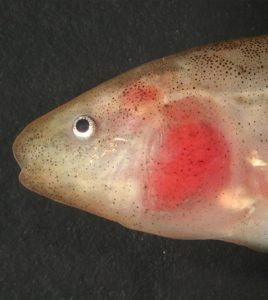How Feathertail Knife Fish Can Lie To Each Other
As humans, we can sometimes tell when we’re being lied to. A shift in gaze, lack of eye contact, and changes in voice tone are all good indicators that something’s up.
But science is still working to understand how some fish can tell if they’re being deceived. And it’s not so easy to do, especially considering that we can never feel what fish feel. All of our evidence has to be gathered, often through manipulative laboratory experiments, and then perceived and described through our sense of sight and hearing. Still, there are strides being made in this area.
Given evidence that animals capable of communication are capable of lying, the next question for scientists is: How can fish tell when another is lying? In an experiment to investigate, researchers at Florida International University relied on the feathertail knife fish.
This slim, freshwater fish species is known to lie to other fish about how big it is, something indicative of how well it’s eating and, by extension, how well it could do in mating and providing for young of its kind. The fish uses a weak pulse of electricity to map its environment and communicate with others of its kind nearby.
Typically, the larger the feathertail knife fish, the more electric signal (noise) it can produce. But, it is possible for smaller fish to inflate the noise they give off so as to appear larger to fish farther away.
For this reason, females of the species have to be careful about which noise they choose. And the same goes for males, who key on the noises to figure out which areas have fish that they can possibly bully out of territory.
To test these dynamics, the Florida International scientists set up tests using a series of connected fish tanks outfitted with speakers that permitted researchers to listen in on noises the feathertail knife fish gave off.
In one experiment, the researchers fed some male and female fish all the worms they could eat. But for another group, the food supply was intentionally limited. Going into the test, scientists thought that the fish on a diet would make less noise just because they had less energy to do so. Though that is not what researchers found.
Instead of releasing less noise, the food-stressed fish put out more, researchers say. And it seems that they do so because they want one more shot at mating before they die. Indeed, some of the feathertail knife fish expend so much energy to be louder that they knock themselves out.
But does the fake display of size work on other fish? It’s not yet clear. However, the researchers have embarked on a few tests to see.
In one, they place a female between two males in three separate, but connected, tanks. With all fish in dark conditions so that none can see one another’s true size, scientists see which side the female moves to. Males of the fish are also studied in this way, as they use the noise to guess where they will be most successful in gaining territory.
Though it’s hard to say if these fish can tell when they’re being deceived, researchers have at least pinpointed that there are various degrees of trust displayed by the fish. Some trust every noise, while others trust no noise. Other fish give noises a chance one day and not the next. These different approaches appear remarkably similar to those that we humans display when assessing the trustworthiness of others.

(Credit: Will Crampton / University of Central Florida)



0 comments